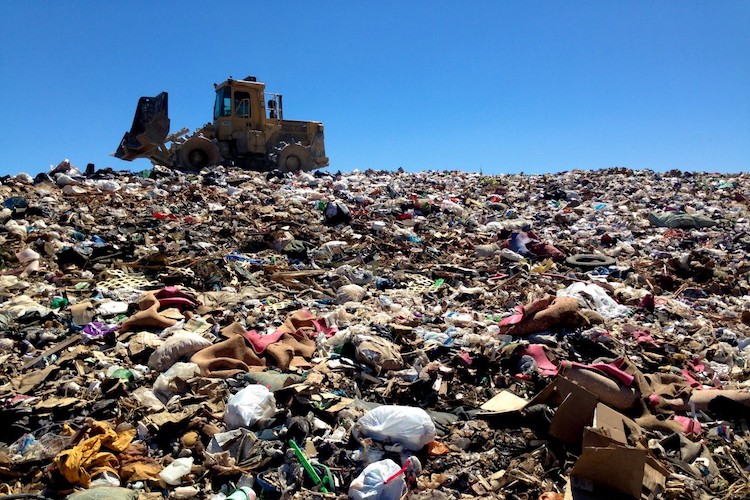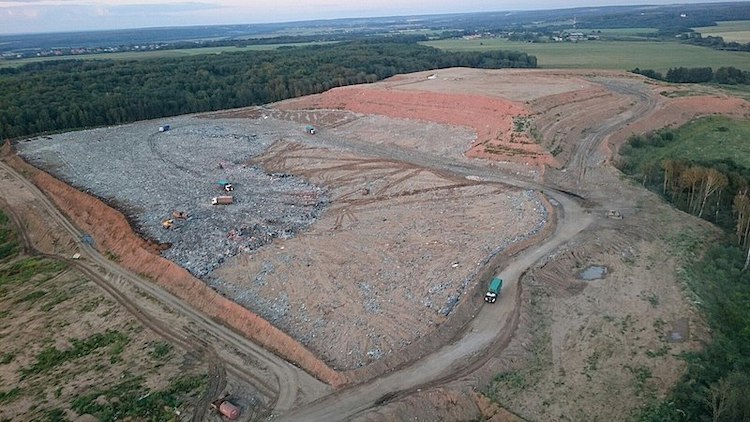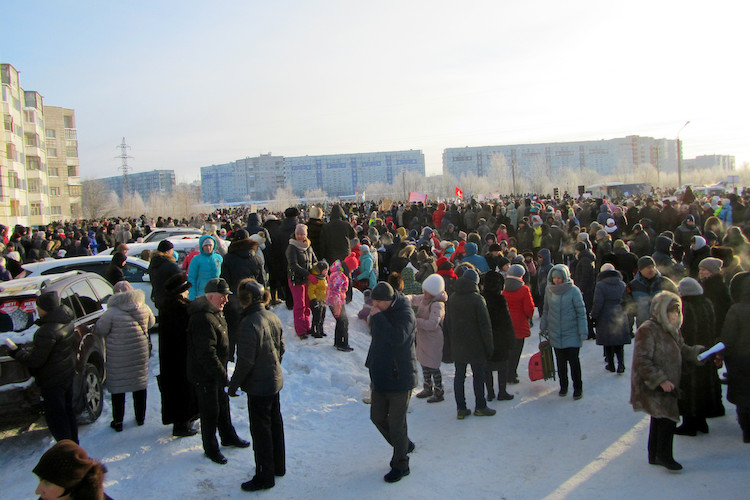In January 2019 Russia embarked on a significant reform of waste management, an increasingly visible and emotive issue that has led to protests in several regions in recent years. Eighteen months later it seems that the reform, instead of solving this issue, is highlighting some chronic policymaking problems.

About 90 percent of garbage in Russia ends up in landfills, only 3-8 percent is recycled. Photo: Alan Levine (pxhere.com)
Russia’s waste policies
Russia produces more than seven billion tons of waste every year. Most of it is industrial waste: two-thirds is linked to oil, gas, and coal extraction and a further 22 percent to the mining of metal ores—this kind of waste, barring an industrial disaster, is rarely visible to the average Russian. The 2019 waste management reform concerned the visible part—municipal solid waste (MSW), or, as most people know it, garbage. Russia generates more than 60 million tons of this every year. Per capita, this is not a particularly large amount: the average American generated twice as much in 2019. However, in Russia roughly 90 percent of garbage ends up in landfills, as opposed to around 50 percent in the US. A significant amount ends up in illegal landfills. Only between 3-8 percent is recycled—as opposed to 35 percent in the US.
The low level of recycling in Russia is not related to cultural animosity to the sorting and recycling of waste—the crux of the problem is bad policies. The Soviet Union had state-sponsored programs to collect recyclable waste (paper, glass, scrap metal, etc.) separately. In the 1990s, however, this system fell apart together with the USSR, and illegal landfills proliferated. A 2004 reform tried to improve waste collection by making municipalities responsible for shaping and implementing relevant policies, but underinvestment and a lack of genuine interest meant that the situation as a whole hardly changed. Waste processing facilities were built, but, according to data from the Russian Ecological Operator (REO), a body set up to oversee the revamp of waste collection, only about 10 percent of their capacity is used.
Landfills became a source of public discontent, especially around Moscow, which generates between one-sixth and one-fifth of Russia’s total MSW. Since 2017, residents of the Moscow region have been protesting against landfills situated around their homes—a total of 39 in the area. When in 2017 the people of the Moscow region town of Balashikha complained to Vladimir Putin about a local landfill Kuchino during his annual Direct Line telethon, it was closed. Still, protests continued, culminating in the 2018 Volokolamsk demonstrations, triggered by toxic gases from a local landfill, which caused a great stir in the media. By the end of 2019, 27 more landfills had been shut down, leaving the Moscow region with only 11 facilities and a problem to solve.
The authorities came up with a plan to create landfills for Moscow’s waste in other regions—a policy that was intentionally kept from the public view, but still encountered admirable resistance from local protest movements in the Arkhangelsk Region and the neighboring Komi Republic. Ultimately, the protesters’ resilience forced the local authorities to shut down the landfill construction project. According to the Russian Public Opinion Research Center (VTsIOM), a state-affiliated pollster, Russians view waste collection as the second most important ecological problem in the country after poor air quality.
The reality of the reform
The 2019 waste management reform—part of Vladimir Putin’s National Projects (“Ecology”)—was meant to address these concerns and clean up the mess, literally. It envisioned raising the proportion of recycled MSW to 36 percent by 2024, reducing the number of illegal landfills, and giving regional governments powers to oversee waste management by setting up local operators that would have exclusive rights to handle municipal waste.
Yet, a year and a half after the reform started, it does not look like this is where Russia is headed. It seems that the only people satisfied with the reform are businessmen close to Russia’s ruling elite—in particular Rostec CEO Sergey Chemezov, the son of Russia’s former prosecutor general Igor Chaika, and businessmen Arkady Rotenberg and Yuri Kovalchuk, whose companies, according to a recent report by IStories, received almost a quarter of waste disposal contracts under the new rules established by the reform. Companies associated with local political elites won contracts in 30 regions.
What is more, Moscow and St. Petersburg, the two largest cities of the country, were allowed to postpone switching to the new system until 2022. Moscow drew up new plans to build landfills and five incineration plants in the Moscow, Kaluga, and Vladimir regions, regardless of the continuing protests.
Across the cities as well as in the regions, waste collection fees went up by more than 50 percent. One of the reasons for the hike is the lack of competition, which allowed waste collection companies with political connections to name higher prices for their services. Another reason is the new algorithm for calculating waste collection fees, which now accounts for household square footage. Its introduction resulted in higher prices for pensioners who live alone in relatively spacious apartments compared to families and young people sharing the same living area.

Aleksinsky Quarry, a landfill site for household waste located in Klin (about 45 miles away from Moscow), was officially closed in 2014, but continues to be used as an illegal waste dump. Photo: DoberSoft (Wikimedia Commons).
Still, on balance, waste collection fees are rarely transparent. When regional operators determine the capacities of waste collection companies, they are relatively free to estimate how much waste a person or a business is expected to create in a year—this parameter determines budget appropriations for the matter. As a result, large discrepancies have emerged even between regions with similar characteristics: e.g. 0.84 cubic meters (or 30 cubic feet) per person in Krasnoyarsk vs. 2.3 cubic meters (or 81 cubic feet) in Novosibirsk. Some operators built a surcharge into the fee, ostensibly to finance the construction of new waste processing plants, even as trucks continued offloading waste at local landfills. The Federal Antimonopoly Service routinely finds violations by regional waste collectors that overcharge people, e.g. by overstating the transportation component of their prices.
This obscure tinkering is both a cause and a consequence of residents and businesses refusing to pay waste collection fees. According to REO head Denis Butsaev, 20-35 percent of the population and 65-70 percent of businesses did not pay for waste collection in 2019. As a result, those who are willing to pay are vastly overcharged for inferior service. In some regions, these underpayments led to the breakdown of the entire waste collection system, with garbage rotting on the streets.
Take the Chelyabinsk region, where the local operator CKS established control over most of the market. In Chelyabinsk itself, this meant contracting an associated company to have waste transported as well as acquiring a stake in the city’s only landfill. Not only did this vertical integration upset the existing waste collection system, it also delayed costly investments into waste sorting and waste processing plants. In Magnitogorsk, another big city in the same region, a waste crisis erupted in January 2020, after CKS cited low efficiency to reduce the fees that it paid to Spetskomplex, a local contractor with links to the former vice-governor, which separated recyclable waste from the rest. Spetskomplex then threatened to cease operations altogether. The dispute dragged on.
In Tyumen it was the regional operator’s insistence on an intermediary that upset a functional local initiative—people sorting their own household waste. Following the reform, however, the region chose to build a waste sorting plant and included a hefty surcharge in the waste collection fee for the sorting. Activists successfully challenged some aspects of the regional waste collection system, but not the surcharge, which resulted in citizens abandoning voluntary separation and hauling their waste off to landfills instead.
Policy failures
The above incidents highlight fundamental design flaws in Russian policymaking that are not unique to the issue of waste management, but which are underlined by the reform’s failures.
First, the authorities’ proclivity for engaging the “right” people instead of good policies. Since the targets of the waste collection reform are set in the National Projects, and thereby tied to Putin personally, officials dogmatically pursue them. But when it became clear that no strategy had been drawn up to incentivize citizens and businesses to separate waste, a federal law made it possible to regard waste incineration as recycling if the burning of trash generated heat or electricity, despite the negative environmental impact. Such data are often falsified or hidden, as happened in the case of the Timokhovo landfill in the Moscow region.

February 2019: Protests in the Arkhangelsk region against the landfill construction in Shiyes. Photo: Alexey Schekinov (Wikimedia Commons).
Second, preference is given to corruptible policies—e.g. waste plant construction, which comes with lucrative contracts and kickbacks to officials, instead of complex solutions that would require restructuring of the system and behavior change. The 2019 reform envisaged building hundreds of waste processing plants even though the existing ones are running below capacity. This initiative has done close to nothing to reduce the amount of unseparated household waste, discourage companies from using non-recyclable packaging, allow supermarkets to give groceries beyond sell-date to charities instead of landfilling them, or even address the fact that most regions do not even have waste sorting schemes. As the Tyumen and Chelyabinsk examples show, some outcomes of the reform may have even set back recycling. Regional operators are not interested in reducing the total amount of waste that they process, while their politically connected contractors will often look for shortcuts to make a profit.
For all the attention that the Kremlin has supposedly paid to the problem of waste collection, the reform is not going in the right direction. Correcting the course will not only require diverse solutions, but also money, which is in short supply. Some experts say that to increase the share of recycled household waste to 60 percent, 3 billion rubles ($42 million) will have to be invested for every million ton of MSW every year for the next five years. This makes about 150-200 billion rubles ($2.1-2.8 billion) per year—roughly half the amount that the Kremlin was willing to allocate to regions to help them deal with the COVID-19 aftermath. In the case of the pandemic, the Kremlin, albeit belatedly, understood the gravity of the situation, but there is little evidence of that when it comes to waste management. While the protests in Volokolamsk and Shiyes became a cause for concern for Moscow, these local issues did not translate into countrywide protests and could be solved by narrow measures, e.g. closing facilities, relocating the projects, and firing officials.
However, a growing number of Russians are becoming conscious of the problem and its impact on their daily lives—from filthy public spaces to contaminated water and air. Local protest movements against waste management failures showed that this issue has the potential to bring people together and galvanize civil society. The Kremlin has largely tolerated these initiatives as long as they did not become political. But as Russians in pursuit of cleaner streets increasingly clash with poor policies and powerful vested interests, they will eventually realize that waiting for inept local and national governments to solve the problem is a waste of time.

